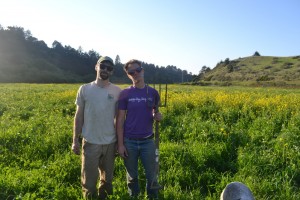The California drought is a narrative of subtraction. On the South Coast, some agricultural producers – particularly row crop farmers and those who raise animals – started the season with less water than they’ve ever had and are finishing the summer with even less. Their new goal: ration well enough to stay solvent next year.
Farms that rely solely on water in Butano Creek, which flows from the slopes of the Santa Cruz Mountains to the ocean, are hardest-hit, as are ranches that need rainfall to turn their pastureland green for animal forage. Local berry farms have suspended their U-pick operations because of the berry’s limited supply.
Blue House Farm, which relies on Butano Creek, has been painstakingly hand-watering rows of tomatoes and other produce because there isn’t enough water in the creek to irrigate several rows at once. The farm also recently installed a water tank to ration water from the creek.
Fifth Crow Farm, one of the largest employers in the area, also relies on Butano Creek and has been white-knuckling through the season by using water saving measures such as drip irrigation, watering at night when the creek has fewer water users, and planting crops that don’t require much water, like winter squash and green beans.

Teresa Kurtak, Fifth Crow Farm
“We’re in the process of getting an even smaller pump so that we can slowly draw small amounts of water and continue to fill our tanks without risking running the creek dry,” says Teresa Kurtak, one of three partners who own Fifth Crow Farm. The farm employs 20 people and Kurtak says reduced production may at some point require workforce cutbacks.
That’s what Kerry Lobel is afraid of.
“The agricutural economy is the heart of South Coast life. If people are not able to sustain making a living, then our way of life will really change. And that’s a bad thing as far as I’m concerned,” says Lobel, Executive Director of Puente.
Rainfall in California since winter 2013 is officially the lowest since 1895, according to scientific records, and conditions have already caused $2.2 billion in damages statewide.
The Coastside has always been a drought-adapted community, and farmers here were spared the much of the pain affecting other parts of the state until very recently, according to San Mateo County Agricultural Commissioner Fred Crowder. The county’s latest crop report suggests ranchers are losing production value faster than any other group of farmers. Flower growers and nurserymen often irrigate with potable water, so their supply has not been affected. But “some vegetable growers barely made it by the skin of their teeth,” Crowder says. “This year, if we continue in this drought situation, I anticipate it will see impacts on our vegetable growers.”
Local cattle ranchers and animal farmers were hit hard by the drought as early as March, and have been culling their herds or moving them to another part of the state.
Early Bird Ranch has the capacity to raise 10,000 broiler chickens but is only raising 500 this year, according to co-founder ShaeLynn Watt. “We need more rain to absorb the impact of the chickens so we can use the land more easily,” she explains. “Wind without rain is a concern for topsoil.”
Root Down Farm raises chickens, pigs and turkeys – and vegetables, except for this year. Now the farm is struggling to keep enough water for the animals to drink.

David Evershed and Dede Boies, Root Down Farm
“This is real, people, this is not just something we talk about anymore. A big reason to why we are raising animals and not growing any crops this year is due to the drought,” writes the farm’s website.
The drought may yet prompt some progress around water issues. Kurtak, of Fifth Crow Farm, says regulators are discussing how to create more off-stream water storage (like ponds and reservoirs) – which she sees as a positive sign. “Many local farms would like to put in more ponds to fill in the winter when water flow is high, but the bureaucracy and red tape are intimidating and costly and hamper those efforts. Maybe this will stimulate the regulatory agencies to figure out how to simplify and streamline that process,” she explained.


